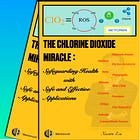This excerpt is from my book, "The Chlorine Dioxide Miracle: Safeguarding Health with Safe and Effective Applications." If you're interested in chlorine dioxide therapy, you can purchase the book here:
The formation of acne is primarily caused by three factors: First, excessive secretion of oils, especially during puberty when hormones stimulate the sebaceous glands, leading to a large amount of oil excreted through the pores; second, if the old keratinized cells are not effectively shed during the skin’s metabolic process, they can block the pores, resulting in oil accumulation and the formation of bumps; third, these bumps alter the structure of the skin, and the increased pressure may cause the skin surface to rupture. At this point, acne bacteria, which rely on skin oils for survival, can invade and cause infection, ultimately leading to the formation of swollen pimples, including acne, blackheads, whiteheads, or folliculitis.
Generally, acne is removed by squeezing pustules, but frequently doing so can enlarge the wounds and lead to repeated skin infections, eventually leaving acne scars. The correct method for acne removal should be three-pronged: clear away the aged skin cells to keep the pores open; kill the acne bacteria and regulate the immune response to prevent infection; and regenerate new skin to heal wounds.
7.1 The Mechanism of Chlorine Dioxide in Treating Acne
The treatment of acne with chlorine dioxide involves several key mechanisms: Firstly, it helps to clear away aged and damaged skin cells, including senescent cells and cancer cells, to ensure pores remain unobstructed; secondly, chlorine dioxide possesses antibacterial properties effective against acne-causing bacteria, aiding in immune response regulation and reducing infections; finally, it may promote the regeneration of damaged tissue and restore immune balance by modulating the immune system. This approach avoids the skin damage and infections caused by physical squeezing, thus treating acne more effectively and reducing the formation of acne scars.
Under my guidance, many individuals have used chlorine dioxide to treat their acne, often seeing complete clearance of facial acne after three consecutive applications, with the entire
face regaining smoothness within a month (Figure 9).
7.2 Acne Treatment Protocol
A. To prepare chlorine dioxide:
Weigh 100 grams of sodium chlorite solid (powder, 80% purity, the remaining 20% being sodium chloride) and add it to 900 milliliters of deionized water (or distilled water). Heat the mixture to about 50 degrees Celsius until the solid is fully dissolved, then cool to room temperature to create an 8% sodium chlorite solution.
Weigh 200 grams of citric acid solid (analytical grade, 99.9% purity) and add it to 800 milliliters of deionized water (or distilled water). Heat the mixture to about 50 degrees Celsius until the solid is fully dissolved, forming a 20% citric acid solution.
Mix equal volumes of the two solutions above and wait for about 5 minutes to produce a saturated solution of acidic chlorine dioxide (approximately 3000ppm, or 3mg/mL).
B. Storing chlorine dioxide:
Since chlorine dioxide easily evaporates from water, it is generally recommended to prepare it on-site for immediate use. If you need to prepare a larger quantity for long-term storage, it is advised to store it in a glass bottle in a refrigerator at 2-8 degrees Celsius.
C. Method for treating acne:
Apply the acidic chlorine dioxide solution gently with a cotton swab to the affected acne area. For specific acne lesions, apply once daily, for no more than five consecutive days, then allow the acne to heal naturally.








I wish I knew this 50 years ago when I was a teenager. I make a chlorine dioxide spray and use it every morning on my face and eyes, (careful of strength). It also resolves skin cancer on my face.